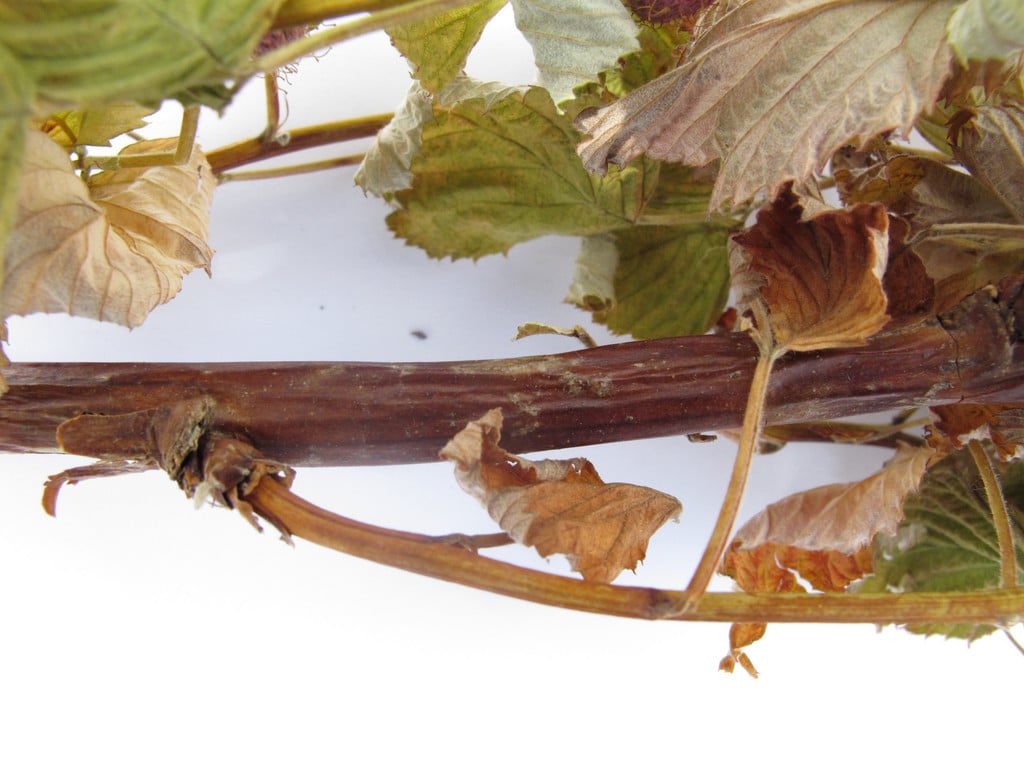Raspberry cane blight
Raspberry cane blight is a common and serious fungal disease of raspberries, causing extensive die-back of canes.

Quick facts
Scientific name: Paraconiothyrium fuckelii, syn. Leptosphaeria coniothyrium
Plants affected: Raspberries (occasionally roses and strawberries)
Main symptoms: Canes die back
Caused by: Fungus
Timing: Visible from mid-summer onwards
What is cane blight?
Cane blight is a disease of raspberries caused by the fungus Paraconiothyrium fuckelii, which infects the developing canes through wounds, causing them to die back. The disease is often associated with attacks by raspberry
Blackberries can also be affected, but on them the disease is of little significance. The fungus causing raspberry cane blight can also cause a canker disease of roses and a root rot of strawberries.
Symptoms
You may see the following symptoms:
- During summer, leaves on fruiting canes wither and the canes die
- The bases of the canes become dark brown, and the bark may split. Tissues below the bark are brown. The wood becomes very brittle so that the canes snap off easily at the base
- Tiny, black fungal fruiting bodies, just visible to the naked eye, are produced on the infected wood
Control
Non-chemical control
- Handle canes carefully to avoid unnecessary damage
- Ensure that they are well spaced so that air circulates and the canes dry out quickly after rain or heavy dew
- Avoid plant stress by providing appropriate soil conditions, for example by improving drainage on heavy soils and mulching around the canes to prevent the soil drying out during periods of drought
- Prune only during dry periods
- Where the disease develops, cut out and dispose of any affected canes. Cut back to below soil level and disinfect the secateurs between cuts
- Do not plant raspberries or strawberries in an old raspberry bed without first changing the soil
- The raspberry cultivar ‘Julia’ has some resistance to cane blight
Chemical control
There are no fungicides available to home gardeners for the control of raspberry cane blight.
Biology
Spores are produced by the tiny black fruiting bodies and are splashed by rain and infect the canes if they remain wet. A second type of fruiting body is produced on old canes in spring, releasing spores that can be carried for long distances on the wind.
Infection invariably occurs through a wound to the cane. The wounds can be caused by a number of factors, including pruning damage and frost cracks. The fungus invades frequently through areas of feeding damage caused by the raspberry cane midge. When this happens, the disease is often referred to as midge blight.
Poor soil conditions, such as waterlogging, weaken the plants and make them more susceptible to attack. The fungus is able to survive for some time in the soil on buried raspberry wood.
Get involved
The Royal Horticultural Society is the UK’s leading gardening charity. We aim to enrich everyone’s life through plants, and make the UK a greener and more beautiful place.